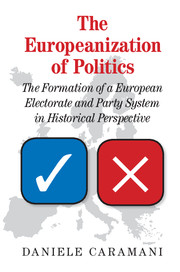 The Europeanization of Politics
The Europeanization of Politics Book contents
- Frontmatter
- Contents
- List of Figures
- List of Tables
- Preface and Acknowledgements
- List of Abbreviations
- Introduction: Electoral Integration in Europe
- Part I Framework
- 1 Theoretical Framework: Europeanization in Historical Perspective
- 2 Research Design: European Party Families and Party Systems
- Part II Analysis
- Part III Assessment
- Conclusion: Towards Europe-wide Representation
- Appendices
- References
- Index
2 - Research Design: European Party Families and Party Systems
from Part I - Framework
Published online by Cambridge University Press: 05 November 2015
- Frontmatter
- Contents
- List of Figures
- List of Tables
- Preface and Acknowledgements
- List of Abbreviations
- Introduction: Electoral Integration in Europe
- Part I Framework
- 1 Theoretical Framework: Europeanization in Historical Perspective
- 2 Research Design: European Party Families and Party Systems
- Part II Analysis
- Part III Assessment
- Conclusion: Towards Europe-wide Representation
- Appendices
- References
- Index
Summary
Introduction
The analysis that follows in the five chapters in Part II of this book is based on a data collection covering 713 national and seven EP elections spread across 30 countries over roughly 150 years of electoral history in Europe. This chapter addresses general issues of cross-sectional and cross-temporal comparability that such a broad comparative and longitudinal analysis entails. This chapter further addresses other general methodological issues to clear the way as much as possible for the analysis in the rest of this book.
As seen, the analysis of Europeanization of electoral politics is multi-pronged in the type of data it relies on. Yet – whether analyzing electoral results, party manifestos, cabinet data, or surveys – the basic units of analysis are political parties and party families. The homogeneity of electoral support across countries is based on a definition of party families. Similarly, the uniformity of electoral swings in Europe is based on simultaneous gains or losses of equivalent parties in different countries. The level of ideological cohesiveness and convergence among European parties of the same family (based on manifestos and voters’ preferences) also requires a classification of national parties into Europe-wide families. Finally, the analysis of similarity of cabinet composition across countries has party families as its basic unit. In all cases party classification is crucial for the analysis in this book.
The first task of this chapter is, therefore, to build party families and a classification useful for diverse countries and over a period of more than a century (first section of this chapter). To do this, what henceforth is referred to as “the cleavage model” is used, and various aggregations of families are proposed. This section also addresses aspects relating to the data file, codes, and overall indices as the number of parties, fractionalization, volatility, and disproportionality. Second, this chapter provides an overall picture of the “European” party system (second section of this chapter). This serves as a reference for the analysis of “deviation” of single countries or areas in Europe. It is the overall “model” against which variation of national systems is measured in Part II. Time periods covered for each country and issues relating to different electoral years are also addressed in this section.
- Type
- Chapter
- Information
- The Europeanization of PoliticsThe Formation of a European Electorate and Party System in Historical Perspective, pp. 41 - 68Publisher: Cambridge University PressPrint publication year: 2015


